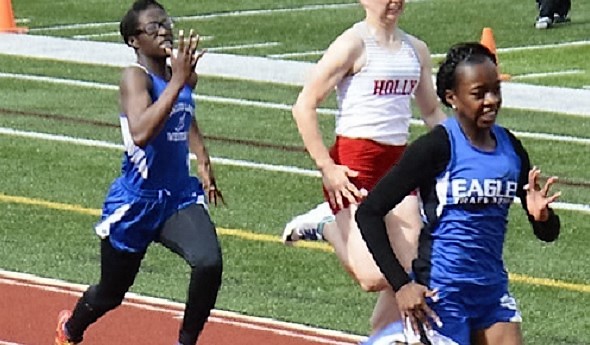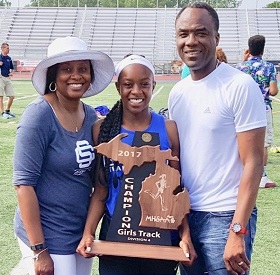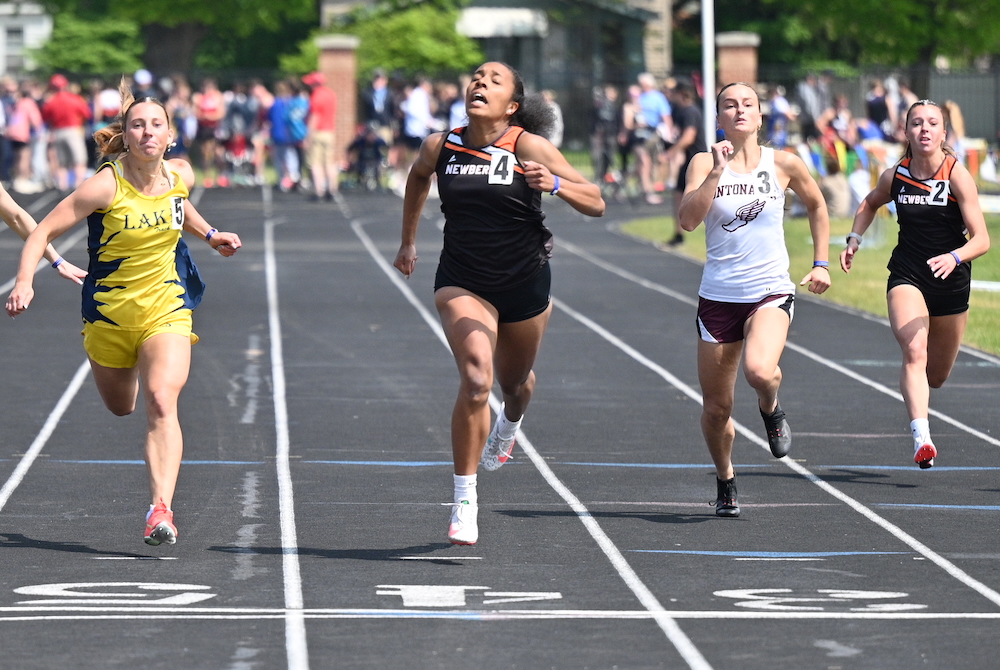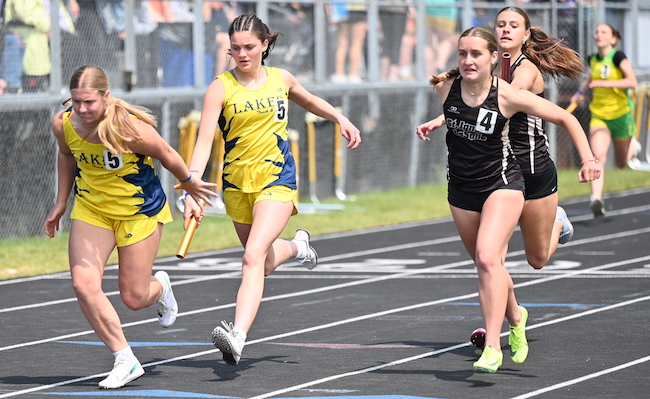
Sprint Star Leads Southfield Christian Surge
By
Tom Markowski
Special for Second Half
May 2, 2018
SOUTHFIELD – The village of Grass Lake, located in Jackson County, and the country of Nigeria are worlds apart in many ways.
 But at Southfield Christian, chance circumstances have brought the two together – and the results have had a positive effect in the classroom and in the sport of track & field.
But at Southfield Christian, chance circumstances have brought the two together – and the results have had a positive effect in the classroom and in the sport of track & field.
Todd Crouch ran track at Grass Lake High School and then in college at Spring Arbor before graduating in 2007. Crouch became a substitute teacher at Grass Lake soon after graduation, and he also helped coach the track team.
But securing a full-time teaching position wasn’t easy. Remember the times. The recession of the late 2000s left few unscathed.
“I applied, applied and applied,” Crouch said. “I graduated in 2007, and the recession followed. It was a situation where people who were working were holding onto their jobs, and art teachers weren’t in high demand.
“Then someone, I don’t even know who this person was, slipped me a sticky note. There was a message to contact a person. I had no idea what was going on. I’d never been to Southfield, and here I was contacting the superintendent at Southfield Christian, Sue Hoffenbacher, about a possible interview and Sue told me that she had been waiting for my call. I interviewed on a Friday, and on Monday I had the (teaching position).”
That was 2010. Crouch is now in his eighth season also as the girls and boys track & field coach at Southfield Christian and he teaches art classes at the high school level and at the middle school, which is located on the same campus.
In retrospect, Crouch said it was his destiny to coach and teach at a religious school like Southfield Christian.
“It’s a good story,” he said. “God meant for me to be here.”
It gets better. Southfield Christian won its first MHSAA track title last season, when the girls team finished with 62 points, 10 ahead of second-place Fowler at the Lower Peninsula Division 4 Finals held at Houseman Field in Grand Rapids. The program’s previous best finish was runner-up in 2007.
Chika Amene and Kaelin Ray, both juniors last season, were the stars on that team. Amene placed first in the three sprints and ran the third leg on the winning 1,600-meter relay team. Ray ran the second leg in that race, placed first in the 300 hurdles and third in the 100 hurdles.
Of the six athletes who qualified for last year’s Finals, five were possibilities to return this spring. Two of those five, however, are not competing in track at this time. Crouch said Ray is focusing on club volleyball this spring. Junior Grace Sanders competed in Southfield Christian’s first two track meets but suffered an injury also playing club volleyball – she could return to the track before the end of this season and was part of last year’s 800 relay that finished third at the Finals.
But Crouch remains optimistic his team can contend for another title. The Chargers have 16 on the girls varsity team, and a number of those athletes have stepped up and shown much improvement over last season – including seniors Grace McFerrin and Shelby Goodson, who both ran on the 800 relay at Houseman last spring as well.
 Southfield Christian’s chances begin with Amene, the best athlete in Division 4. Her parents, Chinedum and Uchenna, were born in Nigeria, and both competed in sports. Her mother was a track athlete in high school and Uchenna played soccer in college at University of Detroit Mercy. Amene’s brother, Dubem, is a sophomore and also runs track.
Southfield Christian’s chances begin with Amene, the best athlete in Division 4. Her parents, Chinedum and Uchenna, were born in Nigeria, and both competed in sports. Her mother was a track athlete in high school and Uchenna played soccer in college at University of Detroit Mercy. Amene’s brother, Dubem, is a sophomore and also runs track.
Physically, Chika Amene is stronger this season and competing at a higher level. If she can match what she did last season, that’s 40 points at the Finals, assuming she and three teammates can grab a first in a relay.
Amene has been a sprinter since before junior high. Early on she excelled in the 100 and 200. Gradually, the 400 became her best event. It took Amene until late in her freshman season to approach the 400 seriously, and it took an athlete on the boys team to provide that push.
Blake Washington is a junior at University of Michigan, and his best event is the 400. But it wasn’t always his favorite. Like Amene, Washington concentrated on the 100 and 200 early in his high school career.
“It was at the Regionals of his sophomore year,” Crouch said. “We had some injuries, and we told (Washington) he had to fill in. He ran so well in the (1,600) relay that I said to him, ‘You know, we’re going to have you work on that.’”
Washington set the LP Division 4 Finals record in the 400 in 2015 (49.34) that still stands.
“I was a freshman when Blake was a senior,” Amene said. “The 200, in my mind, was my best. Blake ran the 100 and 200, and transitioned to the 400. I didn’t even think about the 400. In one meet, one of my coaches said to run in the (1,600) relay and my time was really good. So I started training in the 400 as a sophomore.
“(Washington) was like a mentor. He gave me advice on my classes, my school work and running. He taught me a lot in the 400. He told me to make sure I got out fast, to get out hard. In college he told me to have my priorities straight, and don’t get distracted.”
Amene’s time when she won the 400 last season was 58.83. Her personal best is a 57.6. She ran 57.96 to finish 17th in March at the New Balance Nationals Indoor held in New York.
“I’m slowly getting back into shape,” she said. “That indoor season takes a lot out of you.”
A goal-setter, Amene said she hopes to run a 55 flat at the MHSAA Finals.
Amene said she’ll likely follow Washington to U-M. Amene’s grade-point average is 3.7, and she intends to major in business or economics with an eye on law school. She said she’s always been a Michigan fan, and the fact that a second cousin attended U-M doesn’t hurt – that cousin being 2012 Ann Arbor Huron grad Cindy Ofili, who won three LP Division 1 individual titles as a high school senior before becoming a Big 10 champion and Olympian representing Great Britain at the 2016 summer games.
 Tom Markowski is a columnist and directs website coverage for the State Champs! Sports Network. He previously covered primarily high school sports for the The Detroit News from 1984-2014, focusing on the Detroit area and contributing to statewide coverage of football and basketball. Contact him at [email protected] with story ideas for Oakland, Macomb and Wayne counties.
Tom Markowski is a columnist and directs website coverage for the State Champs! Sports Network. He previously covered primarily high school sports for the The Detroit News from 1984-2014, focusing on the Detroit area and contributing to statewide coverage of football and basketball. Contact him at [email protected] with story ideas for Oakland, Macomb and Wayne counties.
PHOTOS: (Top) Chika Amene, far right, leads the pack during a sprint. (Middle) Chika, with parents Chinedum and Uchenna at last season’s MHSAA Finals. (Photos courtesy of the Amene family.)

Taylor Sisters, Nwose Key Newberry's Title Run, Jokela Caps Famed Career
By
John Vrancic
Special for MHSAA.com
June 1, 2025
KINGSFORD — The Taylor sisters have been a mainstay for the Newberry girls track & field team throughout this season.
They provided more than half of their team’s scoring here Saturday, helping Newberry gain its first Upper Peninsula Division 3 Finals championship in a decade with 84 points.
Runner-up Lake Linden-Hubbell scored 76 points, and third-place Stephenson had 52.
“This is also the first time our boys and girls won together, which is very exciting,” said Newberry coach Cori Canfield. “We’re going to lose some good seniors, but we’ll have some good freshmen coming in. I’m optimistic about the next 2-3 years. You prepare the kids for this all year, then it’s up to them to execute the plan.”
Junior Samantha Taylor set a U.P. Finals record in the 1,600-meter run in 5:08.47, shaving nearly 6½ seconds off last year’s record time (5:14.9).
Earlier, she established a school record in the 3,200 (11:42), and sophomore Abby Taylor took the 800 (2:26.71).
“I really wanted to try my hardest in the mile, which is my strongest event, and work hard in the other races, and it paid off,” Samantha Taylor said. “This makes me feel more confident in my training and gives me a little momentum going into the cross country season. Being supported by my teammates and coaches is definitely a highlight. Going into my senior year gives me more motivation because it’s my last year.”
She anchored Newberry to a runner-up finish in the 1,600 relay (4:29.54) and Abby Taylor was runner-up in the open 1,600 (5:30.82) and 3,200 (12:35.24). In the 3,200 relay, Abby anchored the third-place finisher (10:38.89).
 Senior teammate Adanne Nwose won the 100 (12.91), and Lake Linden-Hubbell senior Emily Jokela edged Big Bay de Noc freshman Destiny Bleau on a lean for second place (12.95).
Senior teammate Adanne Nwose won the 100 (12.91), and Lake Linden-Hubbell senior Emily Jokela edged Big Bay de Noc freshman Destiny Bleau on a lean for second place (12.95).
“I worked on my starts this week,” Nwose said. “I was really nervous coming in here. I wasn’t supposed to win the 100, which made for added pressure. It was very nerve-wracking. I didn’t think I had won. There were two people to my right. It was crazy close. I’ve been getting under 13 seconds in the past few meets. I would have been very disappointed if I hadn’t gone under 13 today.”
Bleau won the 200 in a meet and school-record 26.02, followed by Rapid River senior Emma Sundling (26.86) and Nwose (26.93).
“I feel pretty good about it,” Bleau said. “It’s a good way to end the season. There were a lot of schools here I hadn’t seen before. I’d say I had good starts. I think this is something I can learn from.”
Her meet record in the 200, topped the previous best (26.36) by Jamie Dompier of Chassell from 2013.
Jokela, a Grand Valley State recruit, became a triple-winner by taking the 100 hurdles (15.98), 300s (46.46) and 400 (59.84).
“I think the competition draws the best out of me,” she said. “They (Newberry) are a bigger school. We’re happy with where we finished. My starts were pretty good. I think this will give me more motivation to work hard for next year.”
Dollar Bay junior Kiera Isaacson won high jump with a school-record leap of 5-4, and sophomore teammate Laila Bell claimed long jump (15-7) and placed third in pole vault (8-0).
Stephenson junior Faith Cappaert took second in the 800 (2:28.6) and third in the 400 (1:02.35) and 1,600 (5:48.01), and anchored the winning 3,200 relay (10:24.35).
Brimley junior Tallulah Slabosheski captured shot put (33-6½) and discus (109-9).
PHOTOS (Top) Newberry's Adanne Nwose (center) wins the 100 dash by four hundredths of a second over Lake Linden Hubbell's Emily Jokela (far left). (Middle) Lake Linden-Hubbell's Ella Schneiderhan hands off the baton to Payton Goldsworthy and St. Ignace's Jillian Fraser hands off to Gwen Kellan in the 800 relay Saturday. St. Ignace went on to win the race with Chloe Bigger and Tayah Shepard also running legs. (Click for more from Cara Kamps/RunMichigan.com.)

